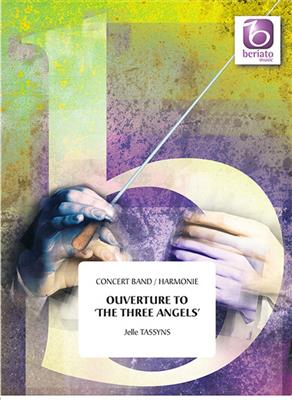Results
-
 £65.99
£65.99Hymn To St. Avold - Claude T. Smith
Serene and lovely describes this chorale prelude. Highlighted by long tones, dynamic contrasts and flowing melodic lines, this work is an effective chorale, or beautiful asset to any concert.
Estimated dispatch 7-14 working days
-
£78.99
Prairie Wedding - Kenley Kristofferson
An absolutely gorgeous chorale weaves its way into a delightful little country wedding dance tune. After a restatement of the chorale, the presto sequences of the dance tune makes a spirited finale. Beautiful writing!
Estimated dispatch 7-14 working days
-
£64.99
Two Bach Christmas Classics - Johann Sebastian Bach
Two timeless Christmas favorites by J.S.Bach are gloriously arranged for the Concert Band and ready for your interpretation. BREAK FORTH, O BEAUTEOUS, HEAVENLY LIGHT and JESU, JOY OF MAN'S DESIRING comprise the two contrasting movements (a Chorale and a Ballad). You know how valuable chorale style playing can be for the band's tone quality, breath support, intonation, and phrasing. With thorough cueing throughout the arrangement, TWO BACH CHRISTMAS CLASSICS will work beautifully even if your group has instrumentation problems. Christmas music does not ordinarily leap to mind as a choice for spring festival use, but you may wish to consider it in this case. Great music isgreat music any time of the year! Magnificent!
Estimated dispatch 7-14 working days
-
£104.99
Partita Piccola - Henk van Belcum
As the title suggests, this work is a partita: it consists of a number of variations on a chorale melody. The partita has been popular for centuries, especially when it comes to organ music. Henk van Belcum, who is active in the choir world, chose for his Partita Piccola the German hymn Wunderbarer Knig as a starting point. Partita Piccola consists of four variations and a choral setting. After a majestic opening fanfare, the second variation follows, based on a canon by Pachelbel. Hndel's Sarabande is the basis of the third variation. Next comes the chorale setting, after which the work ends festively with a dance that has been written in the form of a courante. PartitaPiccola is an asset for church services and for concert platforms.
Estimated dispatch 7-14 working days
-
 £84.99
£84.99Moment Musical - Hayato Hirose
While composing this beautiful chorale, Hayato Hirose was inspired by the fond memory of the pre-marital days he spent with his beloved wife, Minako.The chorale starts with gorgeous woodwinds, after which the brass section is gradually added to enhance the atmosphere. The main theme is repeated and developed in several different keys in the middle section, followed by the recapitulation and the romantic coda that concludes the work. Moment Musical gives any concert programme a touch of warmth and tenderness.
Estimated dispatch 7-14 working days
-
 £92.00
£92.00A Farewell to Arms - Harrie Janssen
A thrilling and joyous spectacle! That's the best way to describe A Farewell to Arms. The chorale "Mach mit mir, Gott, nach deiner Gut", BWV 377, inspired a magnificent piece of music in which all the instrumental sections of the orchestra shine. The composer uses traditional techniques such as the fugato and the chorale. With lots of percussion and epic themes, this masterpiece is a perfect opening number.
Estimated dispatch 7-14 working days
-
 £67.95
£67.95Convergence - Amy Webb
Convergence means "coming together," which is something your band will do very well as they learn to play this song. The composition opens in a chorale style, quickly moving to a faster tempo and returning to the chorale. The 1st trumpet's highest note is B-flat and no clarinets cross the break.
Estimated dispatch 7-14 working days
-
 £104.50
£104.50Arcadian Jubilee - Robert E. Foster Jr.
This stunning showcase for band is based on an original chorale, and exploits the technical and tonal resources of the ensemble. The opening brilliant fanfare leads into a bright melodic section, then the chorale and an exciting finale.
Estimated dispatch 7-14 working days
-
 £104.50
£104.50Rejoice In Glorious Hope - Claude T. Smith
Another in a series of symphonic works based on a chorale; this being Rejoice the Lord is King. Strong rhythmic patterns in percussion and woodwinds against a melodic motive boldly stated by the brass open this intense concert work. A calm development section in the middle featuring solos by euphonium and trumpet leads to a full lush statement of the chorale before ending with powerful ensemble writing above driving percussion. A truly masterful setting for the symphonic concert band.
Estimated dispatch 7-14 working days
-
 £159.99
£159.99Ouverture To The Three Angels - Jelle Tasseyns
This overture was written in 2000 and pays homage to the composer Paul Hindemith. The composition is based on "Es sungen drei Engel. The song dates back to the 12th century and was originally a Christmas carol. Mahler used this melody in his 'Des Knaben Wunderhorn' and in the finale of his third symphony. Paul Hindemith also uses this melody as a chorale in the 'Engelkonzert' of his 'Mathis der Maler' symphony. This melody is not only used extensively in the 'Overture to The Three Angels', it also forms the main theme of the entire central piece. In this central piece, the melody can first be heard as a fugue by the woodwind instruments and then by the brass instruments andultimately ends in a grand tutti which features all the themes of the entire work. The first and the last part of the composition are not based directly on the chorale melody but constitute a contemporary commentary of the central part. These are not literal references but rather the sounds of the heralds.
Estimated dispatch 7-14 working days
